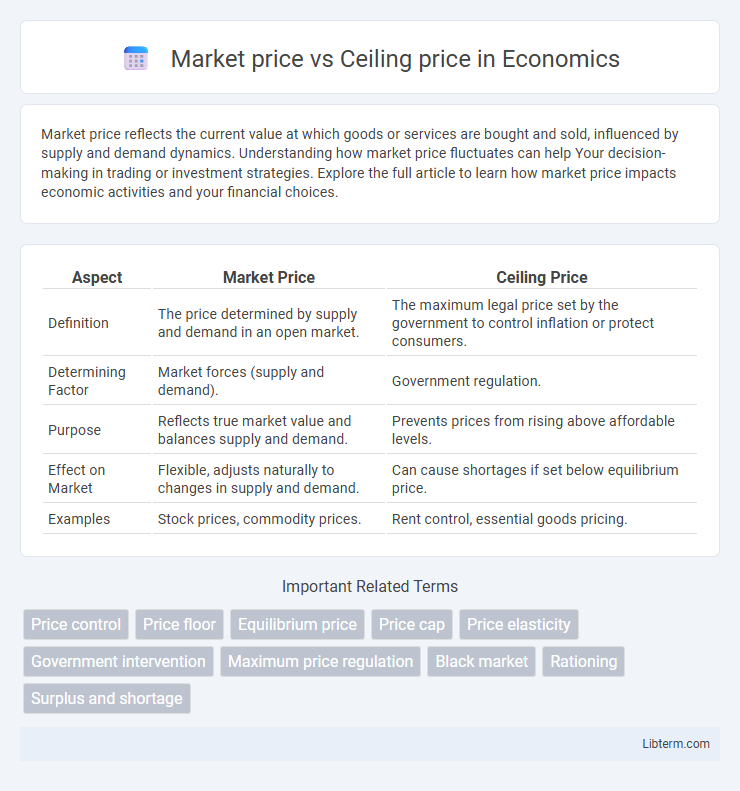Market price reflects the current value at which goods or services are bought and sold, influenced by supply and demand dynamics. Understanding how market price fluctuates can help Your decision-making in trading or investment strategies. Explore the full article to learn how market price impacts economic activities and your financial choices.
Table of Comparison
| Aspect | Market Price | Ceiling Price |
|---|---|---|
| Definition | The price determined by supply and demand in an open market. | The maximum legal price set by the government to control inflation or protect consumers. |
| Determining Factor | Market forces (supply and demand). | Government regulation. |
| Purpose | Reflects true market value and balances supply and demand. | Prevents prices from rising above affordable levels. |
| Effect on Market | Flexible, adjusts naturally to changes in supply and demand. | Can cause shortages if set below equilibrium price. |
| Examples | Stock prices, commodity prices. | Rent control, essential goods pricing. |
Understanding Market Price: Definition and Factors
Market price represents the current value at which goods or services are bought and sold in an open marketplace, determined by supply and demand dynamics. Key factors influencing market price include consumer preferences, production costs, competition levels, and economic conditions such as inflation and interest rates. Understanding these elements helps businesses and consumers anticipate price fluctuations and make informed purchasing or pricing decisions.
What is Ceiling Price? Key Concepts Explained
Ceiling price refers to the maximum price set by regulatory authorities or contracts to prevent sellers from charging excessively high prices for goods or services. It aims to protect consumers from price gouging while maintaining a balance with market demand and supply dynamics. This price control mechanism contrasts with the market price, which fluctuates based on real-time market conditions, including competition, demand, and operational costs.
Comparing Market Price and Ceiling Price
Market price represents the current value at which goods or services are bought and sold in an open market, reflecting supply and demand dynamics. Ceiling price, also known as price ceiling, is the maximum legal limit set by authorities to prevent prices from rising above a certain level, often used in regulated markets to protect consumers. Comparing both highlights how market prices fluctuate freely based on competition, while ceiling prices impose restrictions to control affordability and prevent inflation.
How Market Forces Determine Market Price
Market price is determined by the dynamic interaction of supply and demand within a competitive marketplace, reflecting the price at which goods or services are bought and sold. Market forces such as consumer preferences, production costs, and availability influence this equilibrium price, constantly adjusting it based on current economic conditions. In contrast, the ceiling price is a regulatory limit imposed to prevent prices from exceeding a maximum threshold, which can disrupt natural market adjustments if set too low.
The Role of Government in Setting Ceiling Prices
The government sets ceiling prices as a regulatory measure to prevent essential goods and services from becoming unaffordable during market fluctuations. By imposing a maximum price limit below the natural market price, it protects consumers from potential price gouging and inflation spikes. This intervention ensures equitable access while balancing supply and demand dynamics in critical sectors like healthcare, utilities, and staple food markets.
Effects of Ceiling Price on Consumer Behavior
The implementation of a ceiling price often leads to increased consumer demand as goods become more affordable, creating potential shortages if supply cannot keep pace. Consumers tend to purchase larger quantities or stockpile products, anticipating prices will remain capped, which can distort normal buying patterns. This price control may reduce consumer spending on alternatives, but prolonged ceilings risk diminishing product availability and quality.
Market Price vs Ceiling Price: Economic Impacts
Market price represents the actual transaction cost determined by supply and demand, while the ceiling price is a regulatory limit set by authorities to prevent prices from exceeding a specified level. When the ceiling price is set below the market price, it can lead to shortages as demand surpasses supply, disrupting market equilibrium and causing inefficiencies. Conversely, allowing market prices to prevail encourages resource allocation based on real-time economic signals, promoting optimal production and consumption patterns.
Real-World Examples of Ceiling Price Implementation
Ceiling price policies cap the maximum price that can be charged for essential goods to prevent price gouging during emergencies, as seen in India's regulation of hand sanitizers and masks during the COVID-19 pandemic, effectively controlling inflation and ensuring affordability. In Venezuela, government-imposed ceiling prices on staple foods aimed to curb hyperinflation but led to shortages and black-market growth, illustrating the complexities of price ceilings in real-world markets. These examples demonstrate how ceiling prices impact supply and demand dynamics differently depending on market conditions and enforcement effectiveness.
Challenges and Criticisms of Price Ceilings
Price ceilings disrupt natural market equilibrium by setting maximum prices below the market price, leading to persistent shortages as supply fails to meet elevated demand. These controls discourage producers due to reduced profit margins, often resulting in lower product quality and black market emergence. Critics argue that price ceilings cause inefficiencies and resource misallocation, undermining long-term market stability and consumer welfare.
Market Price vs Ceiling Price: Future Trends and Considerations
Market price and ceiling price play crucial roles in regulating product affordability and market dynamics, with future trends indicating increased reliance on dynamic pricing models driven by real-time data analytics. Advances in AI and blockchain technology are expected to enhance transparency and accuracy in price setting, allowing regulators to adjust ceiling prices more effectively in response to inflation and supply chain disruptions. Emerging considerations include balancing consumer protection with market competitiveness, where adaptable ceiling price frameworks may prevent price gouging while encouraging innovation and investment.
Market price Infographic

 libterm.com
libterm.com